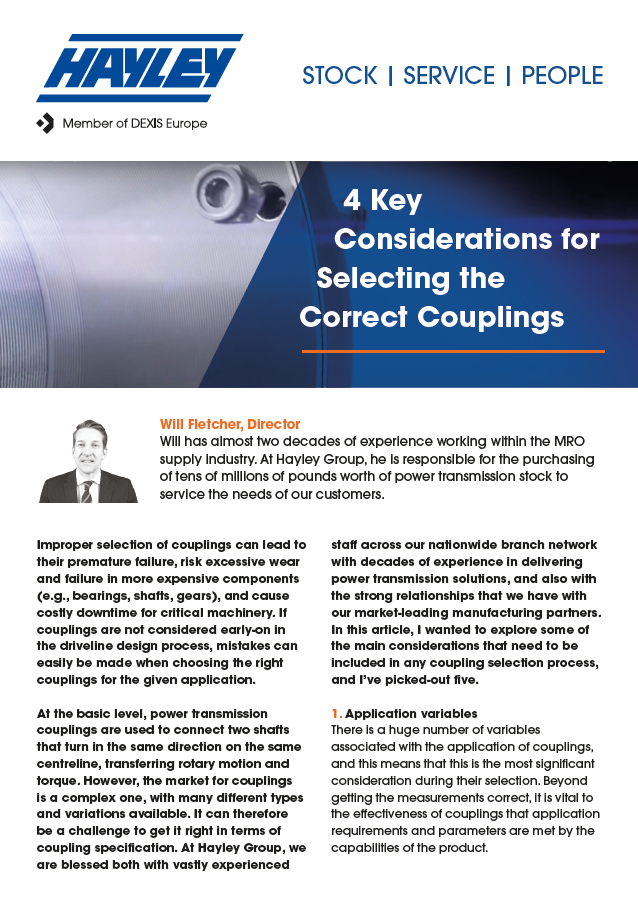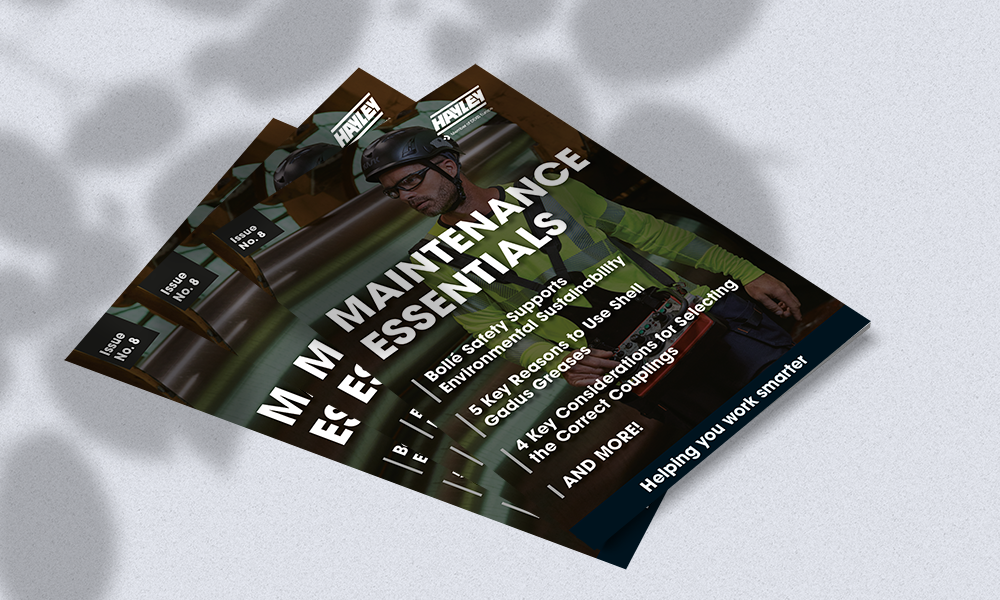Will Fletcher, Director - HQ
Will has almost two decades of experience working within the MRO supply industry. At Hayley Group, he is responsible for the purchasing of tens of millions of pounds worth of power transmission stock to service the needs of our customers.
Improper selection of couplings can lead to their premature failure, risk excessive wear and failure in more expensive components (e.g., bearings, shafts, gears), and cause costly downtime for critical machinery. If couplings are not considered early-on in the driveline design process, mistakes can easily be made when choosing the right couplings for the given application.
At the basic level, power transmission couplings are used to connect two shafts that turn in the same direction on the same centreline, transferring rotary motion and torque. However, the market for couplings is a complex one, with many different types and variations available. It can therefore be a challenge to get it right in terms of coupling specification. At Hayley Group, we are blessed both with vastly experienced staff across our nationwide branch network with decades of experience in delivering power transmission solutions, and also with the strong relationships that we have with our market-leading manufacturing partners.
In this article, I wanted to explore some of the main considerations that need to be included in any coupling selection process, and I’ve picked-out four.
1. Application variables
There is a huge number of variables associated with the application of couplings, and this means that this is the most significant consideration during their selection. Beyond getting the measurements correct, it is vital to the effectiveness of couplings that application requirements and parameters are met by the capabilities of the product.
Torque capabilities of couplings must match-up to the application. If they don’t, and those with an insufficient torque rating are installed, couplings can quickly become damaged and break. Although torque is a variable that is at the forefront of coupling selection, it is frequently underestimated.
Among the other application-related, physical variables are stiffness and inertia, as well as the levels of vibration that the couplings may experience. The stiffness of a coupling depends largely on its material construction and its shape. Stiffness dictates its ability to resist elastic deformation and is therefore more desirable in certain situations than others. For instance, power transmitted as a result of stiffness is undesirable in the event of torque peaks and shock loads. Too much coupling inertia in an application can degrade the performance of a system, and so should be avoided. In particularly dynamic applications, sufficient torque must be created by the drive to overcome inertia in order to accelerate and decelerate, so this must also be a consideration.
In applications where vibration is present, couplings with dampening characteristics will help to reduce the damaging effect that impulse loads and shock are able to have on system components, and also reduce the energy wasted through transmission of vibration.
2. Shaft misalignment
A major reason for premature coupling failure is excessive misalignment occurring between the joined shafts. At its source, many of these failures are caused by the degree of misalignment being underestimated at the point of specification. By selecting a coupling that adequately handles the misalignment conditions of the application, stops the coupling from wearing so rapidly and prevents misalignment causing failure in other driveline components.
Symptoms of excessive misalignment include; signs of powdered rubber or leaking lubricant, premature or frequent bearing and seal failures, more than normal levels of noise and vibration, and high energy consumption. If these symptoms occur it is important to correct the degree of misalignment, often caused by errors at the point of coupling selection or installation. For instance, although flexible couplings are built to allow for one or more type of misalignment and an amount of flex, due diligence should always be paid to all coupling specifications to ensure that they are able to work effectively with the misalignment present. Failure to do this will result in the kinds of problem that I’ve covered here.
3. Lubrication requirements
While lubrication only needs to be considered for certain couplings, improper or insufficient lubrication is still a major contributor for coupling failure. In fact, it is widely accepted that around 75% of all coupling failures is either triggered by misalignment or lubrication requirements not being met. The majority of couplings are supplied grease-lubricated however, the service life of many couplings is largely reliant on the periodic checking of lubrication quality and effectiveness as part of a preventative maintenance regime.
Depending upon the recommendations made by the coupling manufacturer, the application and the operating environment, a coupling may require additional lubrication throughout its lifecycle, typically at six-monthly or annual intervals. There are also products on the market that are 100% lubrication-free, such as the RBI flexible coupling from Renold, immediately able to cut total cost of ownership.
4. Operating environment
Like all other mechanical components, harsh operating environments can have a serious effect on the reliability and longevity of couplings. Ambient temperatures, moisture levels, and any chemicals that your couplings will experience in their operating environment all need to be factored into consideration when making decisions on what products to select. In exceptionally warm environments, heat can travel through the rotating shaft and cause couplings to fail, beginning often with the degradation of grease within the coupling or with thermal expansion. The recommended operating temperature range of couplings is therefore an important piece of information to check if there is any chance that extreme temperatures may affect your application.
Moisture resistance and chemical compatibility are also important credentials to be sure of before installing couplings within an application that may experience moisture or come into contact with chemicals. The material construction of couplings can be unsuitable for these kind of environments as sealing properties and metals susceptible to corrosion can cause irreversible damage.
Conclusion
In conclusion, there are many variables that influence the selection of couplings, some of which are more obvious than others, but all are important to consider during the selection process. Couplings are often an after-thought in the design phase of power transmission systems, but the sooner that you can get an understanding of your applications’ coupling requirements the better. This early consideration will serve you well, as good coupling selection will improve longevity and reduce the risk of failure across the systems’ components.
Right across our nationwide branch network we have people with years of experience in assisting our customers with all of their power transmission and driveline requirements. If you are selecting couplings, we are here to help you source the best option for your application.
For expert assistance on selecting and sourcing the best coupling products for your requirements, speak to your local Hayley Group team: www.hayley-group.co.uk/branch-finder/




